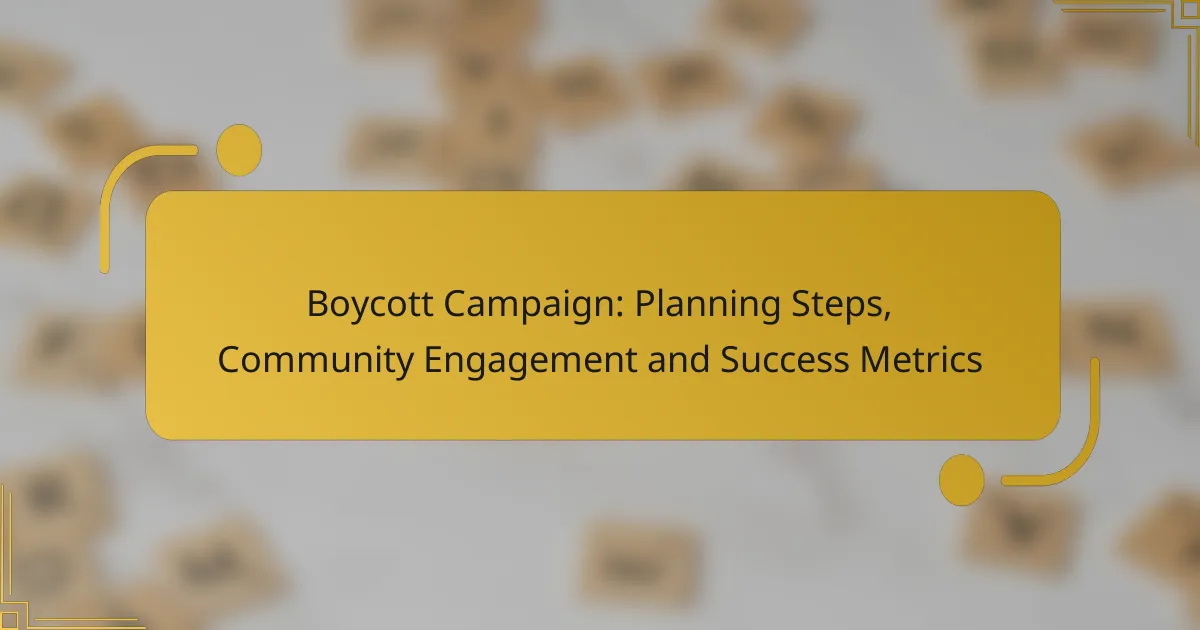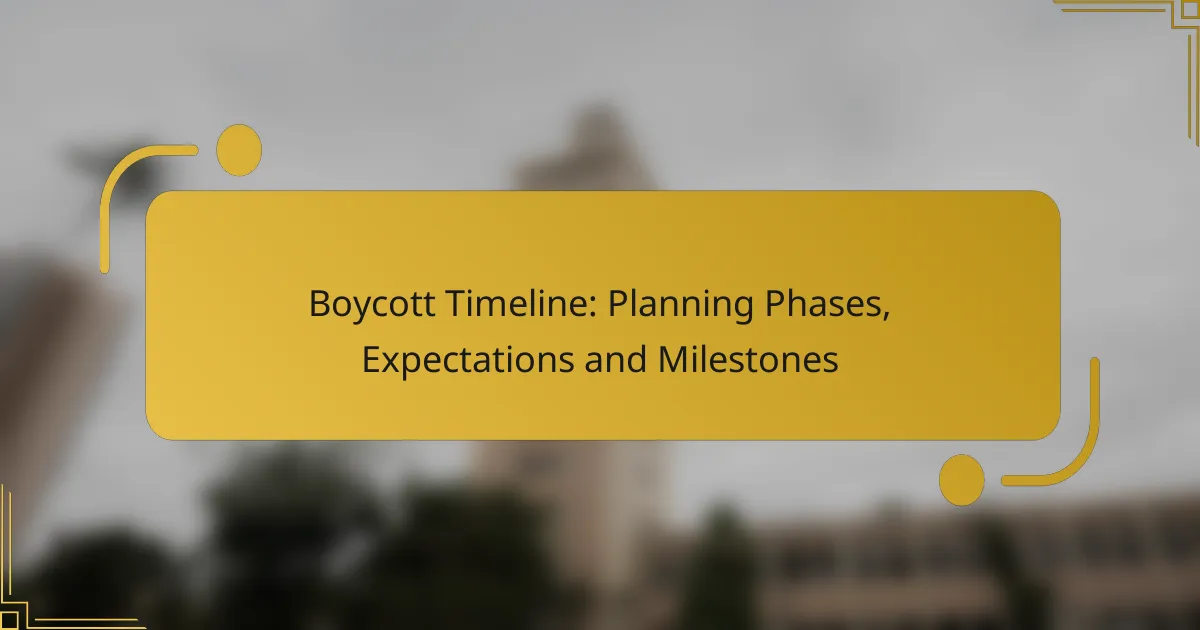A successful boycott campaign requires careful planning and community engagement to drive meaningful change. Key steps include setting clear objectives, identifying the target audience, and developing a strategic messaging plan. Engaging the community through social media, meetings, and collaborations is essential for building support, while success metrics such as public engagement and media coverage help evaluate the campaign’s effectiveness.
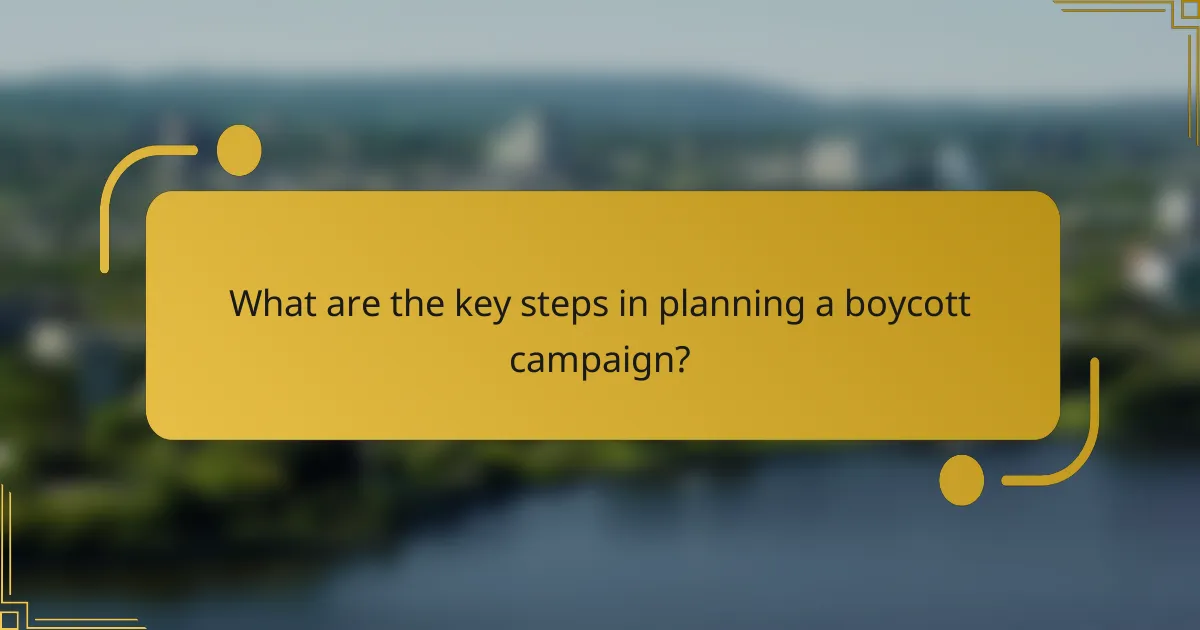
What are the key steps in planning a boycott campaign?
Planning a boycott campaign involves several critical steps to ensure effectiveness and community support. These steps include defining clear objectives, identifying the target audience, developing a messaging strategy, creating a timeline, and allocating necessary resources.
Define campaign objectives
Clearly defined campaign objectives are essential for guiding the boycott’s direction and measuring its success. Objectives should be specific, measurable, achievable, relevant, and time-bound (SMART). For example, an objective might be to reduce sales of a specific product by a certain percentage within six months.
Consider the broader impact of your objectives on community awareness and engagement. Objectives should resonate with the values of the community to foster stronger support.
Identify target audience
Identifying the target audience is crucial for tailoring your campaign effectively. This includes understanding demographics, interests, and motivations that align with the boycott’s goals. For instance, if the campaign focuses on environmental issues, targeting eco-conscious consumers may yield better results.
Engage with community leaders and organizations that represent your audience to amplify your reach. Their endorsement can significantly enhance credibility and participation.
Develop messaging strategy
A strong messaging strategy communicates the reasons for the boycott and its intended impact. Craft messages that are clear, compelling, and emotionally resonant. Use storytelling to illustrate the issues at stake and connect with the audience on a personal level.
Utilize various channels for dissemination, including social media, community meetings, and local media outlets. Consistency in messaging across platforms helps reinforce the campaign’s objectives.
Create a timeline
Establishing a timeline helps organize campaign activities and maintain momentum. Outline key milestones, such as launch dates, community events, and evaluation points. A well-structured timeline allows for adjustments based on community feedback and engagement levels.
Consider seasonal factors or relevant events that could impact the campaign’s visibility and effectiveness. Aligning the timeline with these factors can enhance outreach efforts.
Allocate resources
Effective resource allocation is vital for executing the boycott campaign successfully. Assess the financial, human, and material resources available, and determine how to best utilize them. This may include fundraising efforts, volunteer recruitment, and partnerships with local organizations.
Regularly review resource allocation to ensure that the campaign remains on track and can adapt to any challenges that arise. Flexibility in resource management can lead to more effective responses to community needs and engagement levels.

How to engage the community in a boycott campaign?
Engaging the community in a boycott campaign involves mobilizing local support and fostering awareness about the cause. Effective strategies include leveraging social media, organizing meetings, collaborating with organizations, and distributing informative materials.
Utilize social media platforms
Social media platforms are powerful tools for engaging the community in a boycott campaign. Create dedicated pages or groups to share updates, rally support, and encourage participation. Use visuals and compelling messages to capture attention and spread the word quickly.
Consider using popular platforms like Facebook, Twitter, and Instagram, as they allow for targeted outreach and can help you reach a wider audience. Regularly post content that highlights the reasons for the boycott and its potential impact on the community.
Host community meetings
Hosting community meetings is essential for fostering direct engagement and building a strong support network. These gatherings provide a platform for discussing the boycott’s goals, sharing personal stories, and addressing concerns. Aim for a welcoming environment where attendees feel comfortable voicing their opinions.
Consider holding these meetings in accessible locations, such as community centers or local parks, and promote them through flyers and social media. Ensure to schedule them at convenient times to maximize attendance, such as evenings or weekends.
Collaborate with local organizations
Collaborating with local organizations can amplify your boycott campaign’s reach and credibility. Partner with groups that share similar values or goals, such as environmental organizations, labor unions, or social justice advocates. These partnerships can provide additional resources and networks for outreach.
When approaching organizations, clearly outline how the boycott aligns with their mission and how they can contribute. Joint events or co-branded materials can enhance visibility and encourage broader community involvement.
Distribute informational materials
Distributing informational materials is crucial for educating the community about the boycott’s purpose and importance. Create flyers, brochures, or posters that outline key facts, statistics, and calls to action. Ensure the materials are visually appealing and easy to understand.
Consider placing these materials in high-traffic areas such as local businesses, libraries, and community boards. Additionally, provide digital versions that can be shared online, making it easier for supporters to spread the message within their networks.
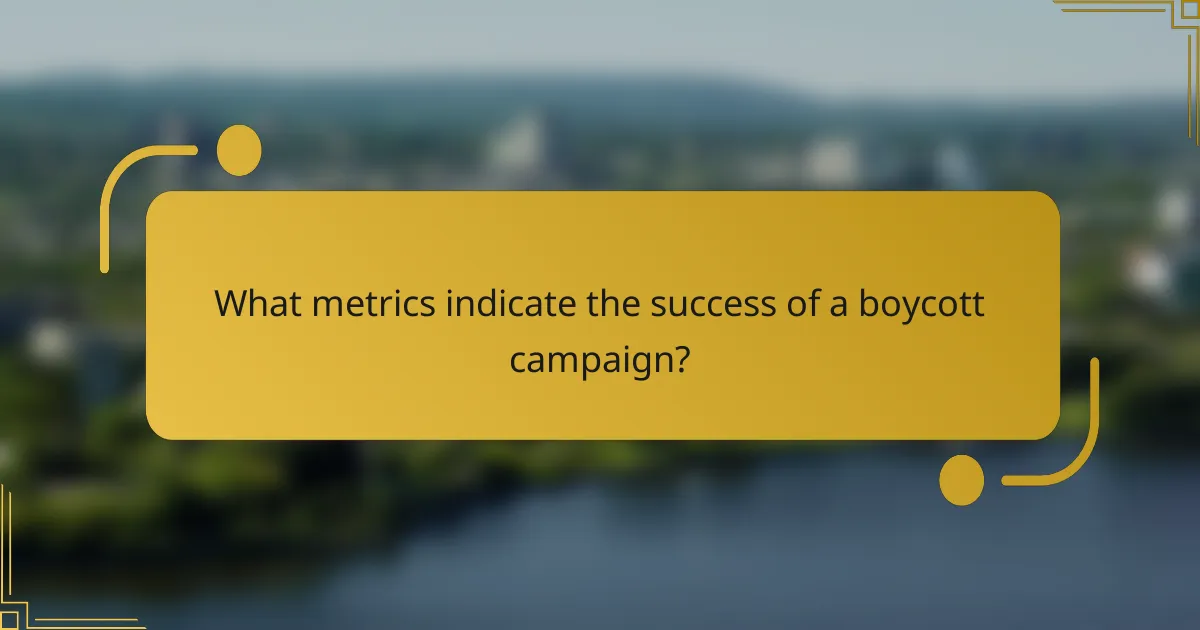
What metrics indicate the success of a boycott campaign?
Success metrics for a boycott campaign include public engagement levels, media coverage, changes in sales or support, and social media reach. These indicators help assess the campaign’s impact and effectiveness in achieving its goals.
Measure public engagement levels
Public engagement levels can be gauged through participation in events, attendance at rallies, and the number of individuals signing petitions. Tracking these metrics provides insight into how many people are actively supporting the boycott.
Consider using surveys or feedback forms to gather qualitative data on community sentiment. Engaging with local organizations can also help amplify outreach and participation.
Track media coverage
Monitoring media coverage is crucial for understanding how the boycott is being portrayed and its reach to the broader public. Analyze articles, news segments, and online mentions to gauge the volume and sentiment of coverage.
Utilizing media monitoring tools can streamline this process. Aim for a mix of local and national coverage to ensure the message resonates across different audiences.
Analyze changes in sales or support
One of the most direct indicators of a boycott’s success is a measurable decline in sales or support for the targeted entity. Collect data on sales figures before, during, and after the campaign to identify trends.
Engage with local businesses or organizations to assess any shifts in customer behavior or support levels. This analysis can help determine the boycott’s economic impact and effectiveness.
Evaluate social media reach
Social media reach can be evaluated by tracking metrics such as shares, likes, comments, and overall engagement on posts related to the boycott. High engagement levels often indicate strong public interest and support.
Utilize analytics tools to measure growth in followers and interactions over time. Consider setting specific targets for social media engagement to guide your campaign efforts effectively.
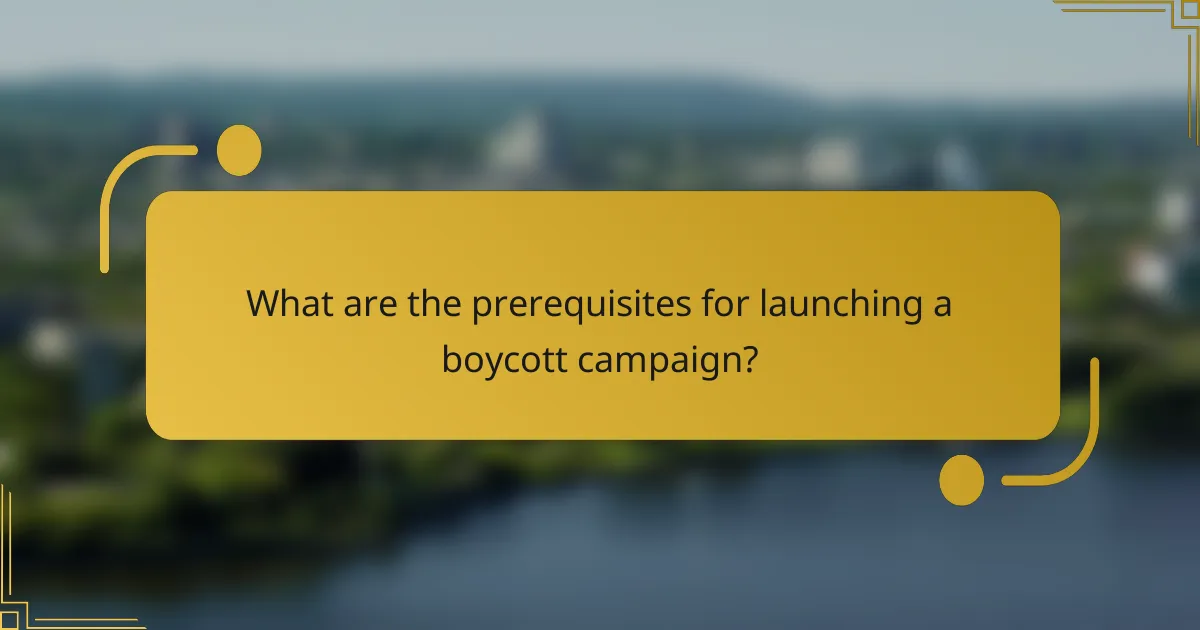
What are the prerequisites for launching a boycott campaign?
Launching a boycott campaign requires careful planning and community involvement. Key prerequisites include understanding the target entity, gauging community sentiment, and forming a coalition to support the initiative.
Research the target entity
Understanding the target entity is crucial for a successful boycott. This involves gathering information about their practices, policies, and any controversies surrounding them. Look for details on their business operations, supply chains, and any public statements they have made.
Consider the impact of the entity on the community and the reasons why a boycott might be justified. For instance, if the entity has a history of unethical labor practices or environmental violations, these points can be pivotal in rallying support.
Assess community sentiment
Before launching a boycott, it’s essential to assess how the community feels about the target entity. Conduct surveys, host discussions, or utilize social media to gauge public opinion. Understanding community sentiment will help tailor your messaging and identify potential supporters.
Look for common themes in the feedback. If a significant portion of the community expresses dissatisfaction with the entity, this can serve as a strong foundation for your campaign. Conversely, if sentiment is largely neutral or positive, you may need to reconsider your approach.
Establish a coalition
Building a coalition is vital for amplifying your boycott efforts. Reach out to local organizations, advocacy groups, and influential community members who share your concerns about the target entity. A diverse coalition can enhance credibility and broaden the campaign’s reach.
When forming a coalition, clearly define roles and responsibilities. This ensures that all members understand their contributions and can work effectively towards common goals. Regular meetings and open communication will help maintain momentum and address any challenges that arise.
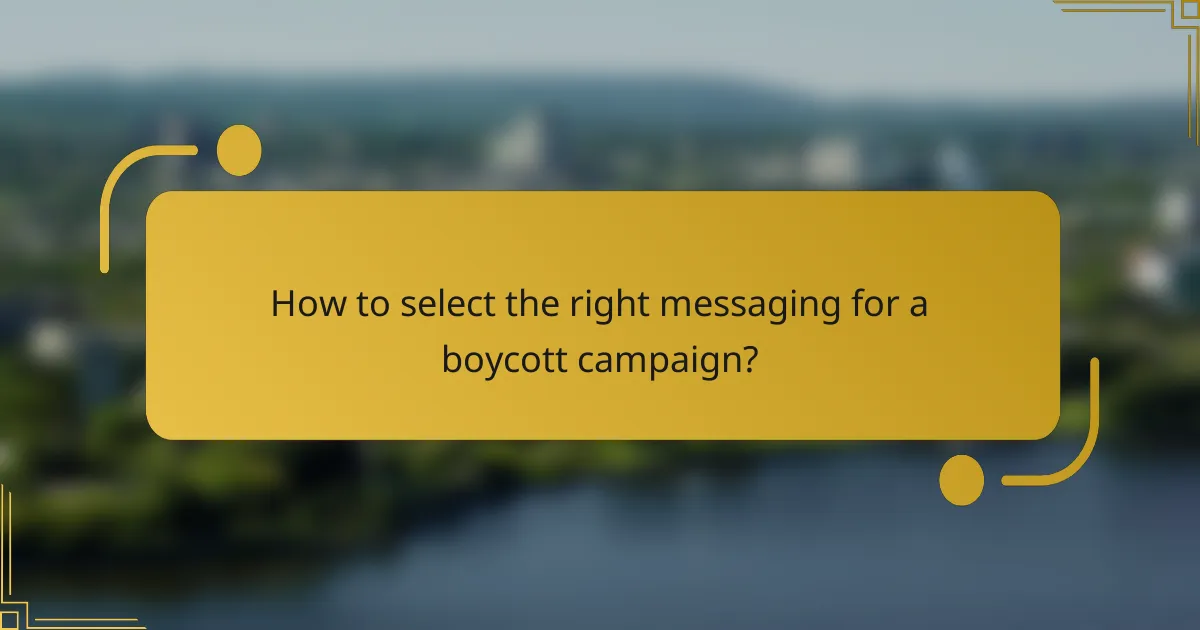
How to select the right messaging for a boycott campaign?
Selecting the right messaging for a boycott campaign is crucial for its effectiveness. The messaging should resonate with the target audience, clearly articulate the reasons for the boycott, and inspire action.
Identify key issues
Start by pinpointing the specific issues that will drive the boycott. These could range from unethical business practices to environmental concerns or social injustices. Engage with community members to gather insights on what matters most to them.
Once identified, prioritize these issues based on their relevance and potential impact. Focus on a few key points to maintain clarity and ensure the messaging is straightforward and compelling.
Craft compelling narratives
Develop narratives that connect emotionally with your audience. Use storytelling techniques to illustrate the impact of the issues at hand, making them relatable and urgent. For example, share personal stories or case studies that highlight the consequences of the targeted actions.
Incorporate strong calls to action within your narratives. Encourage supporters to participate in the boycott by explaining how their involvement can lead to meaningful change. Use clear, direct language to motivate and mobilize the community effectively.
